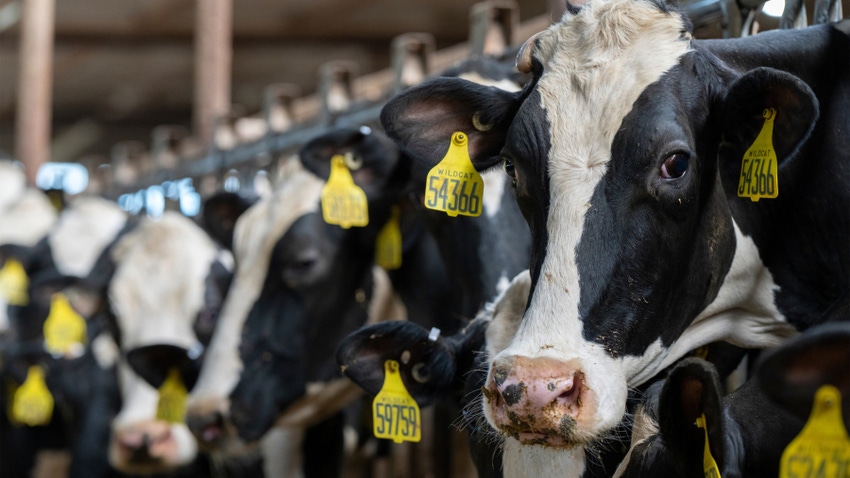
Dairy producers are optimistic 2024 will be better after recent rains offered the promise of more feed and forage production following back-to-back years of drought-related challenges, according to a Texas A&M AgriLife Extension Service expert.
Additionally, the initial passage of Congressional legislation, the Whole Milk for Healthy Kids Act, by the U.S. House of Representatives could signal an increase in demand nationwide, said Jennifer Spencer, AgriLife Extension dairy specialist and assistant professor in the Texas A&M Department of Animal Science, Stephenville.
The past two years have been very tough on Texas dairy producers due to drought. Lower numbers of cows and dairies in Texas reflect the challenging production and market conditions for producers, Spencer said. In 2022, there were 653,000 cows; in 2023, that number had fallen to 635,000. The number of dairies also decreased, falling below 300 at the beginning of 2024, down from 315 in 2022.
However, Spencer said Texas milk production rose in 2023.
“Our milk production per cow went up a little bit, and we are now the third highest milk-producing state in the nation, ranking only behind California and Wisconsin,” she said. “We went from producing 1.648 billion pounds of milk to 1.653 billion pounds from 2022 to 2023.”
Higher costs, falling prices
The largest hit dairy producers took in 2023 was from falling milk prices. Spencer said the uniform milk price fell from $23.68 per hundredweight in 2022 to $18.98 per hundredweight in 2023. And the price of cheese averaged about $2 per hundredweight below both of those.
“With those lower prices and the drought that was experienced for the past two years pushing feed prices higher, it has been very challenging for dairy producers to achieve break-even,” she said.
Spencer said 2024 could be a transition year. She expects a further decrease in dairy numbers, but an overall increase in Texas dairy herd size. The average herd size in East Texas is about 1,000 cows, and in Central Texas, herds are typically in the 1,500 to 2,000 cow range. In the High Plains, dairy herds average 5,000 cows or more.
Most Texas dairy cows are in the Panhandle and account for more than 75% of the state’s milk production. The No. 1 producing county is Hartley, accounting for approximately 19% of Texas’s milk production. By comparison, regions like Central and East Texas account for 15% and 3%, respectively.
Positives on the horizon
Despite challenges, many producers are optimistic about seeing what 2024 brings in the way of feed production and market demand, Spencer said.
“We are hoping for a better crop year, and with the latest precipitation, we don’t expect producers to be struggling as much as the past few years,” she said.
Aside from improved cropping conditions going into spring, the demand for Texas milk could also be heading in a positive direction.
Four different processing facilities are just opening or under construction in the state, which could increase demand for Texas milk. Cacique Foods, a cheese plant, opened in May in Amarillo, and construction of the Great Lakes Cheese Plant in Abilene is scheduled to be completed in late 2024. A milk processing plant in San Antonio to support H-E-B is under construction and scheduled to be completed in summer 2025, and Phase 1 of a Lubbock-based Leprino Foods cheese plant is scheduled to be completed in early 2026.
But the biggest help could come with the Whole Milk for Healthy Kids bill, passed in the U.S. House of Representatives with overwhelming bipartisan support in December. If the bill clears the U.S. Senate, it will return the use of whole milk in schools and greatly increase demand.
Overall, the dairy industry has seen positive trends nationwide as dairy product consumption increased from 538 pounds to 655 pounds from 2022 to 2023.
Technology continues to change dairies
Dairies across Texas are looking at technology more and more to help mitigate the ups and downs of market prices and higher costs. Technology ranging from health monitors to rumination collars are available to help producers manage cow production, and some dairies are integrating robotics to address labor shortages.
“It’s a large investment and learning curve for dairy producers, but if we face more labor shortages or rising minimum wages, these alternative technologies become worth the investment,” Spencer said. “Also, as the next generation of dairy owners move into leadership positions, they are more receptive to adapting the newer technologies.”
Another option dairy operators are looking at to help their bottom line is utilizing more beef-on-dairy breeding. Spencer said sexed semen allows dairy producers to maintain consistent replacement heifer numbers, so producers are looking to take advantage of the higher beef market. A crossed beef-on-dairy calf is valued higher, about $200 per calf at market versus $20 for a pure dairy calf.
“We also may see more dairy producers delve into keeping more of their beef-on-dairy calves and raising them to 800 pounds or so before selling them off,” she said. “Dairies are becoming more versatile.”
About the Author(s)
You May Also Like




